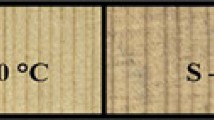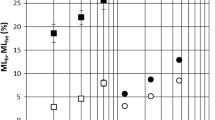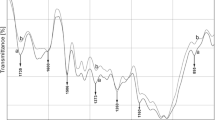Abstract
Heat treatment of wood in absence of oxygen and under mild conditions allows for obtaining a material with many interesting properties, such as enhanced dimensional stability and increased biological durability. The aim of this work was to study the influence of a thermal treatment on the antioxidant activity of the extractives of two wood species – beech and spruce – by using the DPPH method and quantifying the formation of phenoxyl radicals using ESR as wood and extractives are exposed to light irradiation. The relationship between the kinetics of formation of free radicals in the extracts of heat-treated wood and the antioxidant properties is discussed. Links with colour modification are discussed.







Similar content being viewed by others
References
Ahajji A, El Bakali I, George B, Merlin A (2003) Analyse par spectroscopie de résonance paramagnétique électronique (RPE) de bois traités thermiquement exposés à un rayonnement de type solaire. 6èmes Journées Scientifiques de la Forêt et du Bois – Epinal. Annales du GIS bois/environnement, pp 175–182
Avat F (1989) Nature et rôle des extractibles dans la rétification du bois. DEA ENSM.SE, Saint Etienne
Avat F (1993) Contribution à l’étude des traitements thermiques du bois (200–300°C): transformation chimique et caractéristiques physico-chimiques. Thèse de doctorat, Ecole des mines de St-Etienne
Bourgois J, Guyonnet R (1988) Characterization and analysis of torrefied wood. Wood Sci Technol 22:143–155
Brand-Williams W, Cuvelier ME, Berset C (1995) Use of a free radical method to evaluate antioxidant activity. Food Sci Technol 28:25–30
Chrisment A (2000) Color by the numbers. CD ROM DATACOLOR International. Editions 3C – Conseil, Paris
Dirckx O, Triboulot MC, Merlin A, Deglise X (1992) Modifications de la couleur du bois d’Abies grandis exposé à la lumière solaire. Ann Sci For 49:425–477
Fengel D, Wegener G, Heizmann A, Przyklenk YM (1978) Analyse von Holz und Zellstoff durch Totalhydrolyse mit Trifluoressigsäure. Cell Chem Technol 12:31–37
Fengel D, Uçar H, Wegener G (1979) Isolation and characterization of the polysaccharides from beechwood (Fagus sylvatica L.). Papier 33:233–239
Hakkou M, Petrissans M, El Bakali I, Gerardin P, Zoulalian A (2003) Study of the influence of temperature on the wetting of thermal treated wood by light pyrolysis. 9ème Congrès de la SFGP, pp 509–516
Hawkes GE, Smith CL, Utley JHP, Vargas RR, Vierther H (1993) A comparison of solution and solid state 13C NMR spectra of lignin and lignin model compounds. Holzforschung 47:302–312
Ishiguri F, Saitoh K, Andoh M, Abe Z, Yokota S, Yoshizawa N (2000) Improvement of heartwood color of black-colored sugi (Cryptomeria japonica D. Don) by UV irradiation after smoke-heating. Holzforschung 54:294–300
Ishiguri F, Maruyama S, Takahashi K, Abe Z, Yokota S, Andoh M, Yoshizawa N (2003) Extractives relating to heartwood color changes in sugi by a combination of smoke-heating and UV radiation exposure. J Wood Sci 49:135–139
Janin G (1987) Mesure de la couleur: intérêt forestier et industriel. Ann For Sci 44:455–472
Kamdem P, Pizzi A, Triboulot MC (2000) Heat treated timber potentially toxic side products presence and wood cell wall degradation. Holz Roh Werkst 58:253–257
Kamdem DP, Pizzi A, Jermannaud A (2002) Durability of heat-treated wood. Holz Roh Werkst 60:1–6
Kilcullen F (1995) Caractérisation du chêne rétifié: extractibles polaires et apolaires, comportement thermique, mouillabilité, couleur. DEA ENSM.SE, Saint Etienne
Kotilainen R (2000) Chemical changes in wood during heating at 150–260 C. Ph.D. thesis, Jyväskylä University. Research report 80, Finland
Mazet JF (1988) Couleur et qualité des placages de chêne et étude de leur comportement photochimique. Thèse de doctorat de l’Université H Poincaré Nancy 1
Mazet JF, Triboulot MC, Janin G, Merlin A, Deglise X (1993) Modifications de la couleur du bois de chênes européens exposé à la lumière solaire. Ann Sci For 50:119–146
Merlin A, Deglise X (2001) Comportement photochimique du bois non traité. In: Durabilité des bois et problèmes couplés. Hermès Sciences, Paris
Mitsui K, Tsuchikawa S (2005) Low atmospheric temperature dependence on photodegradation of wood. J Photochem Photobiol B Biol 81:84–88
Mouras S, Girard P, Roussin P, Permali P, Dirol D, Labat G (2002) Propriétés physiques de bois peu durables soumis à un traitement de pyrolyse ménagée. Ann For Sci 59:317–326
Nuopponen M, Vuorinen T, Jämsä S, Viitaniemi P (2005) Thermal modifications in softwood studied by FT-IR and UV resonance raman spectroscopies. J Wood Chem Technol 24:13–26
Roy C, Pakdel H, Brouillard D (1990) The role of extracts during vacuum pyrolysis of wood. J Appl Polym Sci 41:337–348
Rousset P (2004) Choix et validation expérimentale d’un modèle de pyrolyse pour le bois traité par haute température: de la micro-particule au bois massif. Doctorat en Sciences forestières et du bois, ENGREF
Sandermann W, Augustin H (1964) Chemical investigation on the thermal decomposition of wood: Part III. Holz Roh Werkst 22:377–386
Singleton VL, Rossi JA (1965) Colorimetry of total phenolics with phosphomolybdic-phosphotungstic acid reagents. Am J Enol Viticult 16:144–158
Sivonen H, Maunu SL, Sundholm F, Jämsa S, Vitaniemi H (2002) Magnetic resonance studies of thermally modified wood. Holzforschung 56:648–654
Tjierdsma B, Boonstra M, Pizzi A, Tekely P, Militz H (1998) Two-steps heat timber: molecular level reasons for wood performance improvement. Holz Roh- Werkst 56:149–153
Triboulot MC (1993) Photostabilisation de la couleur du matériau bois. Thèse de doctorat de l’Université H Poincaré, Nancy 1
Van Acker J, Homan W, Jones D (2004) Wood modification developments. Proceedings – Annual Meeting of the American Wood-Preservers’ Association 100, pp 55–59
Varga D, Van der Zee ME (2008) Influence of steaming on selected wood properties of four hardwood species. Holz Roh Werkst 66:11–18
Author information
Authors and Affiliations
Corresponding author
Rights and permissions
About this article
Cite this article
Ahajji, A., Diouf, P.N., Aloui, F. et al. Influence of heat treatment on antioxidant properties and colour stability of beech and spruce wood and their extractives. Wood Sci Technol 43, 69–83 (2009). https://doi.org/10.1007/s00226-008-0208-3
Received:
Published:
Issue Date:
DOI: https://doi.org/10.1007/s00226-008-0208-3




